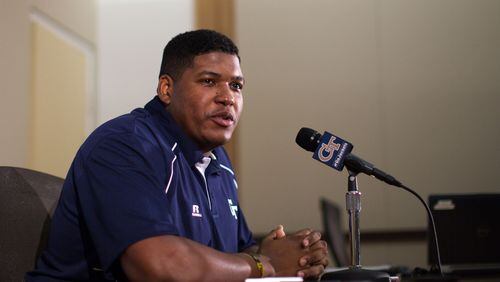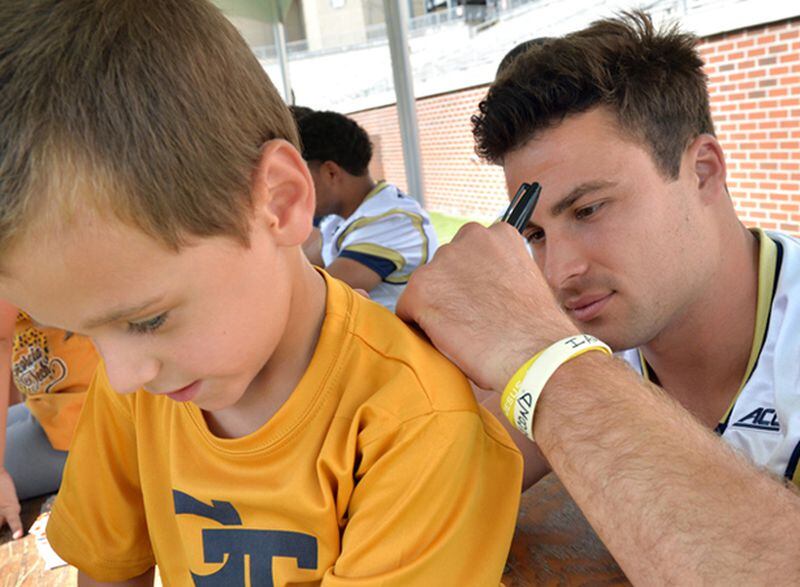In the past couple weeks, Georgia Tech offensive tackle Errin Joe and quarterback Tim Byerly, either directly or through comments from coach Paul Johnson, have indicated an interest in returning for what would amount to a second senior season due to injuries that have taken seasons from each.
As is often the case with NCAA rules go, it’s a little complicated, but their two cases are different in one way and the same in another, and I’m not sure if it bodes any better for one than the other.
A notable difference, even though both players suffered their injuries on the practice field, is that Byerly had already played a game in the season in question and Joe hadn't. Let’s start with Byerly’s case.
Byerly sat out his first year in college, at Middle Tennessee State, in 2011. He transferred to Tech the following year and had to sit out that year as well, 2012. That left him three seasons of eligibility, the third and last of which was this season. However, with his knee injury, he is eligible to apply for a hardship waiver, commonly known as a medical redshirt, to have his final year of eligibility restored. That’s his first step.
There are four criteria that must be met for the waiver to be granted. The injury must take place during the season in question. (Check) The athlete must suffer the injury in the first half of the season and may not have played in four or more competitions or 30 percent of the team’s scheduled contests, whichever is greater. (Check) The injury must be documented by a physician who administered care of the injury and can certify the athlete’s inability to compete. (Check and check, presumably)
If Byerly can meet those four criteria, he will receive back his senior year eligibility. It would be similar to safety Jamal Golden getting his junior year back after playing in the first three games of the 2013 season before a shoulder injury ended his season. It is a cut-and-dried process, and the ACC office handles it.
There’s another step, though.
Getting an eligibility extension
Because Byerly is in his fifth and final year since his “eligibility clock” started running in 2011, he needs to extend his clock to a sixth year, which, obviously, is not the standard.
That is the also the situation that Joe is facing, needing a waiver of the five-year rule.
The NCAA manual states that “this waiver may be granted, based upon objective evidence, for reasons that are beyond the control of the student-athlete or the institution, which deprive the student-athlete of the opportunity to participate for more than one season in his or her sport within the five-year period.”
Cases are judged by the NCAA’s Committee on Student-Athlete Reinstatement. The reason Joe’s case is slightly different is because he never used his eligibility on the 2013 season, as he never played in a game. So, technically, he isn’t trying to recover a spent year of eligibility.
The rule’s language suggests that it perhaps wasn’t necessarily intended for athletes in Joe’s situation, who suffered season-ending injuries in practice before the season, but for more athletes who missed a season because an off-field hardship, like an illness or a family emergency. Further, the rule actually is for athletes who were unable to compete for two years, not one, as is the case with both Joe and Byerly.
But, the rule states, the committee “reserves the right to review requests that do not meet the more-than-one-year criteria.”
What Joe and Byerly have to demonstrate to receive an additional year is that they missed the season due to circumstances beyond their control, which an injury suffered in practice would certainly seem to be.
They’ll also have to explain why two seasons were unavailable for use during their five-year clock. Byerly redshirted and then sat out a year as a transfer. Joe redshirted and then suffered the shoulder injury. Both cases would be strengthened if, rather than having redshirted their first season, they didn't compete due to circumstances beyond their control. A redshirt year is considered a circumstance within control.
Possible precdent
Regardless, there’s hope. The NCAA granted Florida tight end Jake McGee a sixth year in January. McGee had a standard redshirt freshman year at Virginia, played three seasons, enrolled at Florida prior to the 2014 season as a graduate transfer and then suffered a season-ending injury in the first game of the season. He missed one season for reasons beyond his control, and one within his control, as is the case with Joe and Byerly.
A Marist women's basketball player recently was granted a sixth year with circumstances similar to Byerly's. She played her first season at Vanderbilt and sat out the next year as a transfer. In her final three seasons, she played in two and one was recovered by a medical hardship waiver, meaning she, too, could only claim one lost season to circumstances beyond her control.
On the other hand, a men's basketball player at New Hampshire (where, incidentally, Tech assistant basketball coach Tom Herrion's brother Bill is coach) was denied a sixth year with a highly similar situation – two seasons at a first school, third year sat out as a transfer, missed another year with an injury suffered in the preseason, played his fifth and final season.
If the McGee case represents some sort of change in the NCAA’s attitude towards sixth-year cases, then Byerly and Joe are obviously in good shape. Otherwise, it might be iffy. On the surface, Joe and Byerly's case bears similarities with the basketball player at New Hampshire, also.
From my reading, a lot of the sixth-year requests that were granted were for athletes who had indeed missed two seasons, usually to injury, or one season due to injury and a significant part of another, even if it couldn’t be recovered by a medical hardship waiver.
Watching with interest are potentially two more Tech football players who could apply in time – center Freddie Burden and offensive tackle Chris Griffin. Both Griffin and Burden redshirted in their first year and missed another full year with injuries suffered before the start of the 2013 and 2015 seasons, respectively.
We’ll leave the last word to Johnson regarding Byerly and Joe’s chances with the NCAA.
“I don’t know,” he said. “It depends on what day it is. It’s what it seems like sometimes.”
Credit: Ken Sugiura
Credit: Ken Sugiura
Etc.
The Tech baseball team was rated to have the No. 4 recruiting class in the country by Perfect Game, behind Vanderbilt, Florida and North Carolina. The two big prizes in the class are pitchers Jonathan Hughes, from Flowery Branch High, and Tristin English from Pike County. Hughes was a second-round pick of Baltimore and English was taken in the 39th round by Cleveland but was a Perfect Game first-team All-American. Baseball America rated him the No. 146 draft prospect.
Hughes chose to attend Tech and bypass pro ball at a significant cost. Of the 28 second-round picks, 26 signed, according to Baseball America. Of the 26, 18 signed for $1 million or more and the other eight signed for no less than $650,000.
Tech’s volleyball team begins ACC play at Clemson Friday, following it with a Sunday home match against Boston College.








